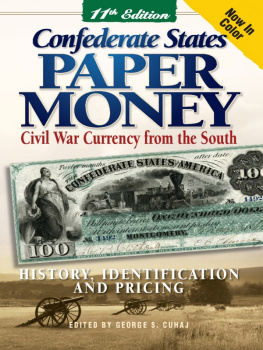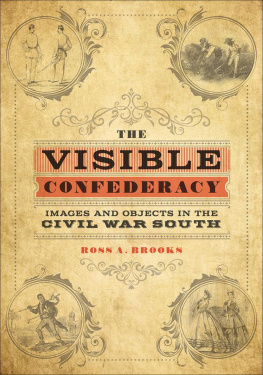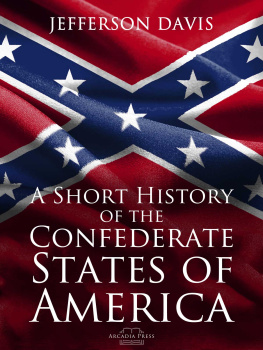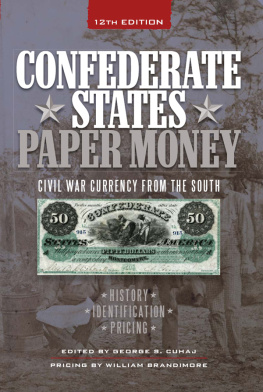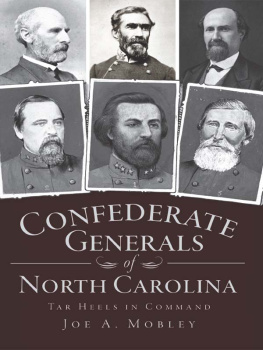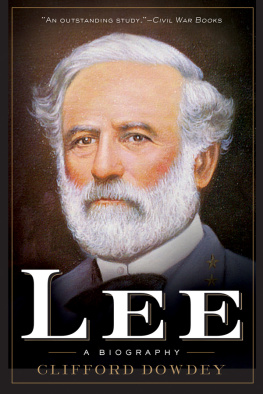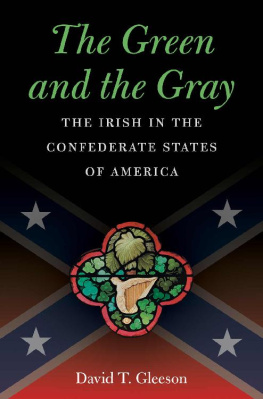University of Virginia Press
2013 by the Rector and Visitors of the University of Virginia
All rights reserved
Printed in the United States of America on acid-free paper
First published 2013
1 3 5 7 9 8 6 4 2
LIBRARY OF CONGRESS CATALOGING-IN-PUBLICATION DATA
Binnington, Ian, 1972
Confederate visions : nationalism, symbolism, and the imagined South in the Civil War / Ian Binnington.
pages cm. (A nation divided : studies in the Civil War era)
Includes bibliographical references and index.
ISBN 978-0-8139-3500-3 (cloth : alk. paper) ISBN 978-0-8139-3501-0 (e-book)
1. NationalismConfederate States of AmericaHistory. 2. NationalismSouthern StatesHistory19th century. 3. RegionalismSouthern StatesHistory19th century. 4. Group identitySouthern StatesHistory19th century. 5. United StatesHistoryCivil War, 18611865Social aspects. I. Title.
F214.B56 2013
973.71dc23
2013005319
All text illustrations courtesy HA.com
Acknowledgments
A book is a collective endeavor for which the author takes sole responsibility. Credit goes to the cloud; blame should go to me. This project began, over twenty years ago, as a senior thesis at Lancaster University written under the direction of the late Marcus Merriman. The intellectual genesis of that thesis took place at the University of Illinois at Urbana-Champaign in the undergraduate classes of Vernon Burton and the late Robert W. Johannsen. What became a dissertation was written, rewritten, and refined under the direction of Vernon Burton, my Ph.D. advisor. Vernons kindness to me as a person, a student, and a friend has been constant since the first day we met. His faith in my ability to complete this project has often exceeded my own, and no one (including myself) has more faith in my virtues as an historian.
At the dissertation stage, Keith Hitchins, David Roediger, Max Edelson, Robert Johannsen, and Kevin Doak all gave good counsel. Bruce C. Levine, then at the University of Cincinnati, provided sharp commentary on the very first piece I wrote on the subject of Confederate nationalism as a graduate student, commentary I have never forgotten nor stopped trying to heed.
In addition to many of the above, Anne Goodwyn Jones, Jeremy Wells, John Mayfield, Don H. Doyle, and Paula Treckel were instrumental in helping me turn a dissertation into a book. More than perhaps anyone, Aaron Sheehan-Dean has read multiple versions and offered substantial, meaningful, and, above all, helpful critiques. A large portion of any credit due on the completion of this project goes to him.
I benefited enormously from the assistance of Linda Jacobson from the Wilson Special Collections Library at the University of North Carolina at Chapel Hill. It was she who suggested Heritage Auctions as a source for images and who specifically suggested that I contact Len Glazer. His generosity in allowing me to use images from HA.com is greatly appreciated. All images appear courtesy of HA.com.
Keeping academics sane is a community endeavor, and I have always benefited from excellent communities. From my time at Illinois, I offer heartfelt thanks to Chad and Tara Beckett, David and Denise Herr, Jon Coit and Sace Elder, John Wedge and Mila Yasko, Jerry and Linda Pelton, Mike Sherfy, Todd and Heidi Larson, and Rob and Amy McLain. At Eastern Illinois University, I was fortunate to make many new friends to add to this circle, not the least of them Michelle LeMaster, Lynnea Magnuson, Michael Shirley, Deb Reid, Anita Shelton, and Martin Hardeman. At Allegheny College, I have too many debts to mention, but foremost among them would be to Paula Treckel, Ron Cole, John E. Guthrie, and Vic Sternby.
My parents, Michael and Janice, have endured throughout this entire process, always asking me how my work was going and never judging when it was not. Their strength, both moral and material, made this project possible as much as anything I did. My sister, Lorna, and my late grandmother Betty Smith similarly provided moral support from the other side of the Atlantic.
Portions of this work were presented at meetings of the Southern Historical Association, the Historical Society, the Social Science History Association, the Nationalism in the New World: The Americas and the Atlantic World conference at Vanderbilt University, and the Douglas Southall Freeman and Southern Intellectual History Conference at the University of Richmond. I would like to thank all participants in those events for their comments and suggestions.
A portion of appears in Virginians and the Civil War, edited by Peter Wallenstein and Bertram Wyatt-Brown. I thank them all for their editorial insights and useful commentary.
Working with Dick Holway and Aaron Sheehan-Dean at the University of Virginia Press has been a delightful experience. Dicks patience and support has been most valued over the years, and he has made this project better in so many ways. I thank the staff of the press, especially Raennah Mitchell, for their patience in answering my questions and their good-natured professionalism. The readers for the press gave me encouraging and substantive critiques, and I hope that I have been able to satisfy most, if not all, of their suggestions and concerns.
Lastly, let me say a word about my immediate familymy wife, Toshia, and my son, Stuart. Without them the dissertation would never have been completed and would certainly never have become a book. They are examples to me in many ways, and I cherish their love and support. It is to them that this book is dedicated.
Confederate Visions
Introduction
On November 20, 1861, Kentucky became the last state to attempt secession from the Union, the thirteenth to do so since the previous December. Kentuckys secession, like Missouris before it, was never entirely effective, but as the last of its kind, her Ordinance of Secession is particularly instructive. According to the aggrieved Kentuckians gathered at Russelville in Confederate-occupied territory, the Lincoln government had
substituted for the highest forms of national liberty and constitutional government a central despotism founded upon the ignorant prejudices of the masses of Northern society, and instead of giving protection with the Constitution to the people of fifteen States of this Union, have turned loose upon them the unrestrained and raging passions of mobs and fanatics, and because we now seek to hold our liberties, our property, our homes, and our families under the protection of the reserved powers of the States, have blockaded our ports, invaded our soil, and waged war upon our people for the purpose of subjugating us to their will.
This statement of defiance set the tone for what was already developing as the narrative thread of Confederate nationalism: Worthy Southrons were innocent of any aggression, only wanting to be left alone to enjoy the exercise of those powers reserved to the states under the Constitution. Southrons were only defending themselves against the unprovoked and merciless depredations of the degraded mob, whose passions had been inflamed by Demon Yankees. Slaves were alluded to (our property) but otherwise did not speak for themselves. The root of the Norths excesses was their usurpation of the Constitution and therefore their rejection of the American tradition of limited government and reserved powers. Northerners were thus un-American, unworthy, and aggressive in their desires to bend others to their capricious will. By implication, Southerners were American, worthy, and peaceful in the maintenance of their way of life.



